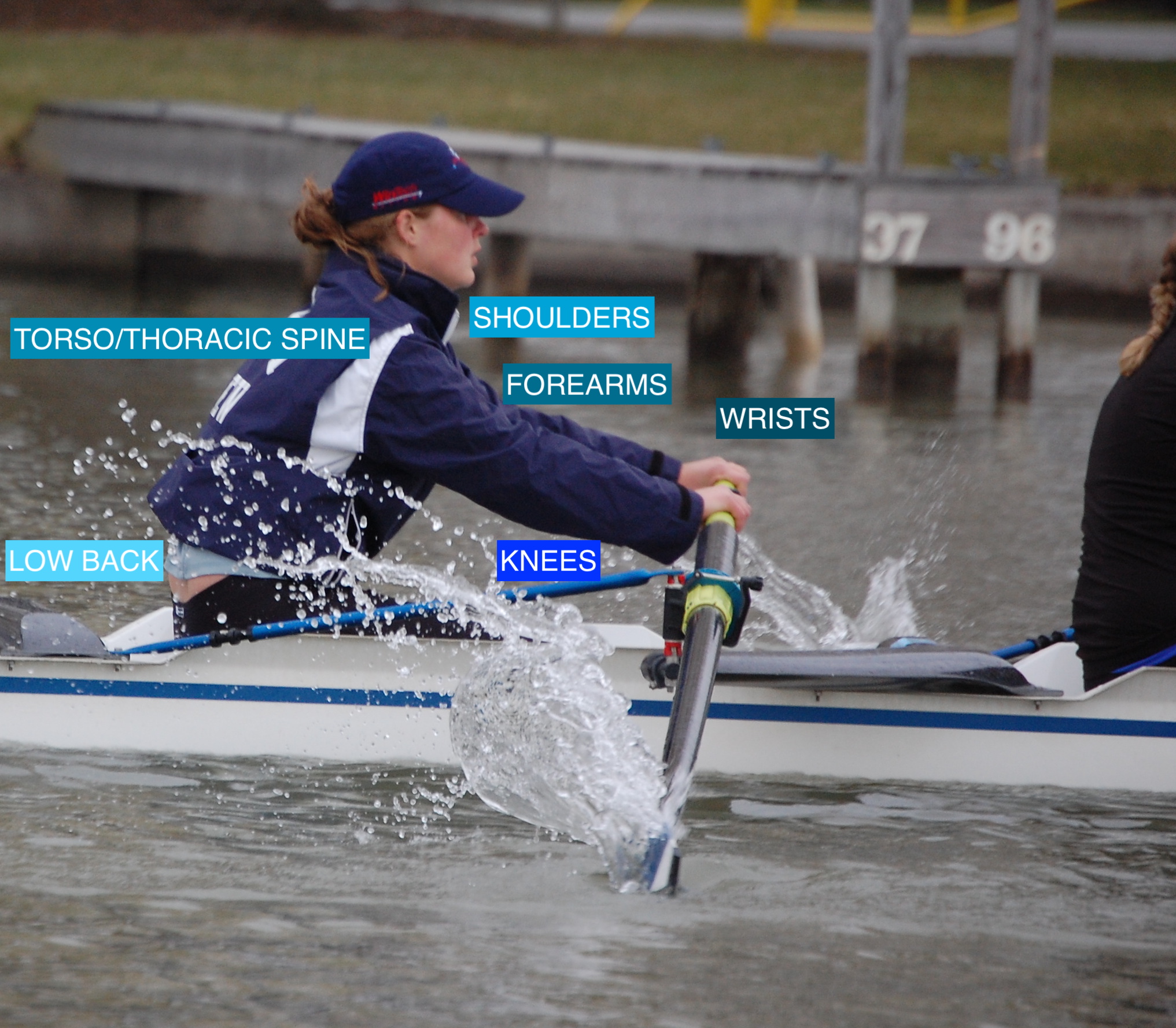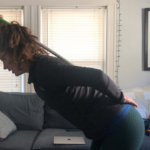Overview:
I wanted to take the time to generally discuss injuries in rowing before going into detail with individual areas or types of injuries. In general, the cool thing about rowing is, we don’t get a lot of serious injuries! Yay Rowing! The not cool thing is a lot of us still row or function with a baseline amount of pain that we just shrug off as “part of it”. My main goal in discussing injuries is to highlight what you can do for yourself to avoid them or decrease your general pain. Also, keep in mind, some injuries don’t necessarily bother us while rowing, they more matter for moving equipment in and out of racks or to and from the dock. It all matters! Now, that said, all studies just look at the act of rowing in terms of mechanisms and injury causes. Overall, I hope to provide problem-solving and awareness beyond just the rowing motion, more taking into account the full picture from arrival at the boathouse to putting your boat safely away when you’re done. The main articles I found to support this post include junior, senior and elite able-bodied rowers. Two groups not represented here are collegiate athletes and para-rowers. Collegiate rowers can overlap with results from junior and senior worlds based on the ages of the rowers. The data for para-rowers is coming because this division of rowing is still on the newer side popularity wise and more time and a larger group is needed for some significant data, that said, in future posts breaking injures down further, as a para rower myself, I’ll do my best to relate injury mechanisms and data to para-rowers. Let us start with a global overview of rowing related injuries!
Common Areas Injured:
Across all ages and experience levels, the most prevalent area injured is the low back. Now, this can range from achy low back pain that goes away once you start moving to disc issues to continuous pain that makes staying on the water difficult. The next most common area is the knee. This might be patellofemoral pain, IT-band issues, or general soreness. Again, lucky us, there are not many meniscus or ligament injuries related to rowing. After the low back and the knee, it gets interesting, upper body or thorax injury rates depend more on the age of the rower, weight class and experience level.
There were three retrospective studies completed in 2007 looking at chronic and acute injury rates among junior, senior and masters elite rowers. The results were published in the following journals:
Smoljanovic, Tomislav, et al. “Acute and Chronic Injuries among Senior International Rowers: a Cross-Sectional Study.” International Orthopaedics, vol. 39, no. 8, 2015, pp. 1623–1630., doi:10.1007/s00264-014-2665-7.
Smoljanovic, Tomislav, et al. “Traumatic and Overuse Injuries Among International Elite Junior Rowers.” The American Journal of Sports Medicine, vol. 37, no. 6, 2009, pp. 1193–1199., doi:10.1177/0363546508331205.
Smoljanović, Tomislav, et al. “Sport Injuries in International Masters Rowers: a Cross-Sectional Study.” Croatian Medical Journal, vol. 59, no. 5, 2018, pp. 258–266., doi:10.3325/cmj.2018.59.258.
All of these were completed at each group’s World Championship regatta. A couple of things to keep in mind as I discuss the findings and their applications, the athletes surveyed were healthy enough to attend worlds and compete. The reports were unable to account for all those athletes who were too injured to even make it to tryouts or who might have been left home because of injury. There were significant numbers of athletes surveyed at each, 743 masters, 634 seniors, and 398 juniors. All surveys concluded similarly that chronic/overuse injuries are the most prevalent type of injury for rowers (male, female, lightweight, open weight). The top area athletes reported was the low back and the second was the knee.
For masters rowers, the third most frequent area injured depends on age. Rowers around 35-years-old, reporting more knee or lower-body injuries and those around 65+ years old who report more shoulder, forearm or wrist injuries. I find this interesting and that with general knowledge of how the body changes with age, it makes a lot of sense! Now to me, knowing that, as we age, our shoulders tend to round forward, lengthening the muscles between our shoulder blades, creating a more rounded upper back posture, the fact that the upper body gets injured more often is not surprising. The postural change makes it more difficult to keep the workload or force generated during a stroke, going through your muscles and out of your ligaments and joints which do not like to take the type of repetitive stress rowing creates. Too much repetitive force through joints like the shoulder, elbow or wrist would cause a breakdown. A couple of other changes our wonderful masters rowers as a whole have to manage are: changing spinal mobility that can occur with aging and lower body joints that might be wearing out (those with impending or already replaced hips and knees) making it more challenging to get power from the legs, placing more strain on the upper body to move the boat. There are some things that we just can’t worry about that happen with aging, but there are some things you can do to keep your body rowing without the low back, shoulder, wrist, elbow, etc pain. Overall knowing that working on strength and mobility through your spine, shoulders and hips are good preventative habits and a starting point to help avoid these injuries.
For junior rowers, wrist and forearm come in third as the area most injured. Given that most are still learning technique at this stage and having their body angles change with growth spurts, this is not surprising. The difference between a high school freshman and a high school senior isn’t just in rowing experience, it’s also in body size, strength and how well the athlete has adjusted to growth spurts that might affect body awareness. The study completed at the 2007 Junior World Rowing Championships showed that the rowers who had grown and developed more had more injuries overall. Why is this? There are many factors, older junior rowers might be asked to complete as part of their training compared to their novice teammates, the most likely of which is more volume. No matter the age group, you add volume with poor technique, not enough base strength, poor body awareness or guidance on how to manage the extra load, injury is likely to occur. The injury rate in juniors is highest of all three groups, likely because of experience, technique, proper core, hip or shoulder stability are difficult to integrate and teach within a junior team, and you add the nature of junior athletes and that’s a whole extra factor. Juniors have the highest rate of ankle injuries, why? Most (hopefully) still participate in a wider variety of sports outside rowing increasing the chance of ankle sprains or the like from activities like soccer or basketball. Keeping some maintenance strength work as part of a routine will help junior rowers avoid some of these injuries and overall help develop good habits for self-care and an injury-free lifestyle overall.
For senior elite rowers, the same starting point of low back pain is consistent for both lightweight and open weight categories. This is the only study where Smoljanovic, Tomislav, et al. broke their findings down into open weight and lightweight categories because there were a few significant findings that differed between the groups. Their survey captured that open weights accounted for 66% of injury reported and light weights 33.4%. As with masters and juniors, chronic injuries are the most common for senior elite rowers, however, acute injuries occurred more often within the lightweights surveyed with male lightweights being the most likely group to have an acute injury. For chronic injuries, both groups have the same top two: low back injuries and knee injuries. For acute injuries, there is a difference in frequency when breaking down injuries by body area. For lightweights, the most reported was the chest/thoracic spine and for open weights, it was shoulder/upper arm. Why the difference? Many factors overall affect an athlete’s susceptibility to injury. We will delve into the many factors that come into play with injury including those already mentioned, strength, body mechanics and mobility but also, nutrition, weight management, recovery methods, and mental health.
Rib Stress Fracture:
Ribs stress fractures I believe are one of the most dreaded, feared and probably most unique injuries to rowing. When someone contacts me saying they have rib pain, there is a lot of worry and anxiety that the athlete expresses. If you walk into a standard PT office or to a general practitioner doctor’s office complaining of rib pain, most likely they will be thinking you’re crazy, “what a rib fracture? That doesn’t happen.” Most likely they have no idea what to do with you. Your coach might not have the best guidance of how to handle rib pain either, it’s an injury that we are all learning how to best handle. I do think that the data reported could be slightly underreported because athletes who sustain a rib stress fracture likely were not able to remain competitive enough though their season to qualify for a world championship regatta. All of that said, there are warning signs, treatments to help prevent and generally if you make your serratus anterior, shoulders and core strong enough to transfer load around and not through your ribs, you won’t have this come your way.
A few things quick things about rib stress fractures:
- Rib stress injuries are most common among Female Elite Senior rowers (according to Smoljanovic, Tomislav, et al the injury rate for senior rowers was about 2% of those at the World Championship 8 women and 4 men reported)
- The earlier you tell someone that you feel pain in your ribs, the better off you are, don’t hide it, it will get worse!
- X-rays won’t show a stress fracture if you get to the point where you expect a break, you need an MRI or Bone Scan (Thornton, Jane S., et al in the article “Rowing Injuries: An Updated Review” published a Rib Stress Injury Guidelines from GB Rowing Team that is a good resource for anyone trying to navigate severity of rib pain)
- They are completely preventable!
Wrap Up:
With all of the data polled, having a “Major Injury” or one where you needed to miss more than a month of regular training is still low with the athletes polled at all three world championship regattas (junior, senior and master). I do think overall the rate is probably slightly higher than the ~3% for juniors and ~5% for seniors that were reported when looking at these groups as a whole and not just those at a world championship. Masters reported ~30% major injures, this might more reflect that masters are more willing to take time off to be healthy than the younger groups. Masters rowers seem to focus on the enjoyment of rowing with competition as a motivator to continue and further their enjoyment while junior and senior elite rowers tend to push the envelope to the point of breaking to gain the most speed possible. Now as we all know, to be the best, the fastest, the strongest and to reach your peak, it takes a lot of work! You won’t be sitting on the line representing the USA at an international regatta without a tremendous amount of work!! That said, there are a lot of us (myself included) who don’t get the chance to meet our goal because of injury. Figuring out how to play the game of doing a maximum amount of work without compromising your body and spending time injured is the hardest part of the game. With this post, I hope you at least gain the knowledge of the body areas you’re susceptible to having injured and are empowered to take care of yourself to avoid spending time injured, away from your team, away from the water and that you afford yourself the skill of being self-aware, listening to your body and communicating with your coach and teammates when something is bothering you. The data shows rowing is not a sport where major injuries are common at least for athletes that reach a world regatta, again, Yay Rowing! But the prevalence of is this because we all are too stubborn and don’t speak up? Rowers run themselves into the ground more often than they stop and look at how they are feeling and seek guidance to “fix it”.
Take-Home:
- Most common injuries across all rowers are low back and knee-related
- Build regular strength, mobility, and self-care into your routine to prevent injuries
- Speak UP! If it hurts to say something, give yourself the chance to keep yourself on the water, the sooner you do something the less time you’ll miss!
- There are lots of factors that go into developing a chronic or acute injury and we will dive into them in future posts
- Educate yourself and get to know your rowing body! (you’re doing great with that if you’re reading this)
Sources referenced:
Smoljanovic, Tomislav, et al. “Acute and Chronic Injuries among Senior International Rowers: a Cross-Sectional Study.” International Orthopaedics, vol. 39, no. 8, 2015, pp. 1623–1630., doi:10.1007/s00264-014-2665-7.
Smoljanovic, Tomislav, et al. “Traumatic and Overuse Injuries Among International Elite Junior Rowers.” The American Journal of Sports Medicine, vol. 37, no. 6, 2009, pp. 1193–1199., doi:10.1177/0363546508331205.
Smoljanović, Tomislav, et al. “Sport Injuries in International Masters Rowers: a Cross-Sectional Study.” Croatian Medical Journal, vol. 59, no. 5, 2018, pp. 258–266., doi:10.3325/cmj.2018.59.258.
Thornton, Jane S., et al. “Rowing Injuries: An Updated Review.” Sports Medicine, vol. 47, no. 4, 2016, pp. 641–661., doi:10.1007/s40279-016-0613-y.



